Embarking on the journey of designing a kitchen can be both exciting and challenging.
It’s an opportunity to create a space that authentically reflects your lifestyle and culinary preferences.
Here are some key steps you could consider:
- Determine Your Must-Haves: This includes both aesthetic preferences and essential appliances.
- Analyze Whole Kitchen Elements: Consider all parts, ensuring they harmonize for the final look.
- Select Ideal Layout: A well-thought-out layout enhances functionality and flow in your kitchen.
- Find Design Inspiration: Magazines, websites, or showrooms can spark fresh ideas for your ideal kitchen.
- Select Suitable Materials: Choose materials that are durable, easy to clean, yet aesthetically pleasing.
- Choose Color Themes: The right colors set the mood and reflect your personal style.
- Choose Worktop Material: This critical kitchen component must suit your needs and design preferences.
Navigating through these steps might make the process of designing a kitchen less overwhelming and more enjoyable for you.
Making It All Work Together
Remember, balance is crucial when incorporating different elements into your kitchen design.
Cabinets proportions, scale and symmetry should align with the overall aesthetic you aim to achieve.
A well-lit kitchen is not only functional but creates a warm and inviting atmosphere. Hence, choose lighting fixtures carefully.
Last but not least, don’t forget to add your personality into the mix with kitchen dressings for that added style touch.
Contents
- Decide on Your Kitchen Must-Haves
- Analyzing Elements of a Whole Kitchen
- Determining Your Ideal Kitchen Layout
- Creating a Detailed Kitchen Floor Plan
- Finding Inspiration for Kitchen Design
- Selecting Suitable Materials for Your Kitchen
- Choosing Color Themes for Your Kitchen
- Choosing the Right Worktop for Your Kitchen
- Selecting Suitable Flooring and Tiles
- Effective Lighting Choices for Your Kitchen
- Utilizing Kitchen Dressings for Added Style
- Finding the Balance: Cabinets Proportions, Scale and Symmetry
- Entertainer’s Kitchen Victory
Decide on Your Kitchen Must-Haves

When planning your kitchen, considering essential features will pay off. Countertops set the tone for your kitchen’s design, and they should reflect your style.
Quartz countertops are a great option for durability and low maintenance, while granite countertops offer a natural, high-end look. If you prefer a rustic feel, go for butcher block countertops.
- Recycled glass countertops are an eco-friendly choice.
- Soft-close drawers and doors provide a smooth, quiet operation.
- Custom cabinetry ensures a tailored fit and unique design.
- Pull-out trash bins offer easy access and hidden storage.
- Spice racks and organizers maximize storage and reduce clutter.
The cooking equipment you choose greatly affects your kitchen experience. Opt for a gas range for precise temperature control, or perhaps a double oven for increased cooking capacity.
An induction cooktop ensures energy efficiency and quick heating, and a Microwave with convection cooking increases versatility. Dining or seating options like an island with stools can provide casual dining space and additional counter room.
In terms of lighting, consider under-cabinet lighting for task lighting, while LED lighting is efficient with a long lifespan. Also remember to choose flooring wisely–hardwood floors offer warmth and durability,
If you want ease of maintenance and moisture resistance, tile floors are a great choice. Lastly, don’t forget to incorporate smart home devices for voice-controlled lighting and temperature.
Analyzing Elements of a Whole Kitchen
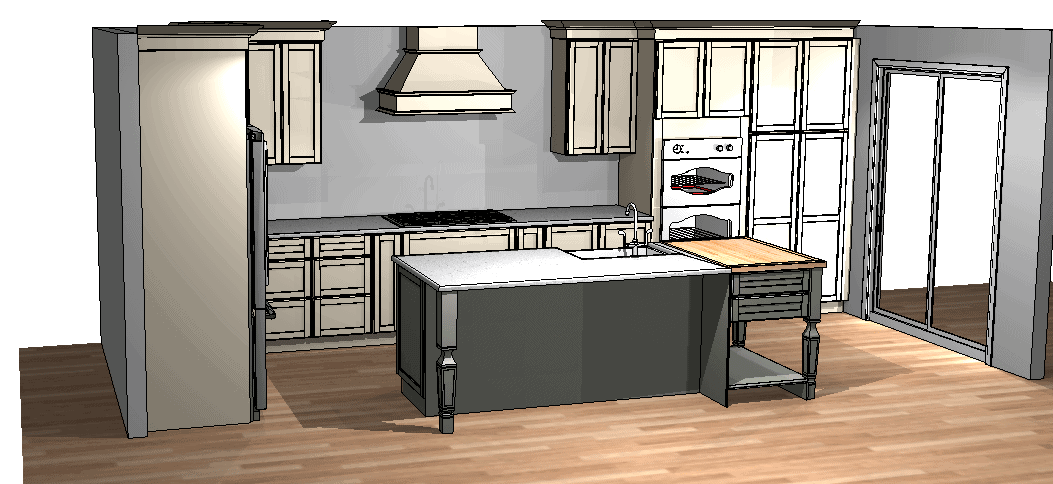
The kitchen renovation was a significant project, resulting in a light-filled space that became the heart of the home.
Cabinets in the kitchen were customized, combining glass-front and solid doors. The glass doors add elegance and display space, while the solid ones offer generous storage.
Beautiful quartz countertops were selected for their durability and easy upkeep. Their white hue imparts a clean, crisp feel, enhanced by a subtle pattern.
A marble backsplash was chosen for its timeless appeal. Its understated veining adds sophistication, while the pale shade makes the space brighter.
The kitchen is illuminated by a mix of recessed, under-cabinet and pendant lighting. Recessed lights provide primary illumination, under-cabinet ones highlight countertops, and pendants add glamour.
The floor incorporates hardwood for its warm look. The dark color contrasts well with light cabinets and countertops, providing visual interest.
The island’s design combines seating and storage. It provides casual dining space or food preparation area besides storage for utensils and cookbooks.
A large farmhouse-style sink was chosen for its functionality and style. A high-arc tap gives the setup a modern appearance.
Stainless steel appliances were picked for their durability and easy maintenance. The spacious French-door refrigerator comes with advanced features like dispensers for ice and water.
Color Scheme
The kitchen colors blend white, gray, and warm wood tones. White gives it a clean look, gray adds sophistication, while wood tones provide warmth.
Layout
The L-shaped kitchen layout supplemented by an island offers ample food prep and cooking space. This layout is efficient and functional.
Design Inspiration
Inspiration for the kitchen design came from Pinterest, Houzz, and design blogs with the aim of creating a bright, inviting space.
Challenges and Decisions
A major challenge was asbestos found in the flooring. Although costly to remediate, the investment in high-quality materials proved worthwhile.
If doing it all over, she would hire a designer or project manager for more support and to avoid renovation stress.
Determining Your Ideal Kitchen Layout

When designing your kitchen, first establish the must-haves. Take time to consider your priorities, including aesthetics and functional necessities. Identifying these elements helps you make informed decisions.
To create an efficient space, work out your ideal layout. The work triangle – sink, refrigerator, and stove – is crucial for household tasks. Ensuring ample room for movement is equally vital.
- Consider the use of work zones and triangles for a functional layout. U- and L-shaped kitchens are popular choices, while single-wall and galley kitchens suit smaller spaces.
- Visualize your space using design software to determine what works best. Overhead views can be particularly helpful in planning kitchen activities.
- Incorporating functional elements, such as a kitchen island, can enhance storage, seating, and counter space. Think about how this fits into your overall aesthetic and dining needs.
To ensure you address all necessary improvements, catalog your current kitchen’s shortcomings. Remembering every detail before starting the redesign guarantees that nothing is overlooked.
Theoretically, each person’s ideal kitchen varies depending on lifestyle. Your habits and personal requirements will influence the final design. It’s essential to inventory everything you own to ensure there’s space allotted for it all.
- Critical design elements include cabinets and storage solutions. It’s important to account for every item in your kitchen and arrange it in a way that streamlines your daily routines.
- Kitchen essentials depend on how you live and cook. A successful remodel considers these factors and incorporates them into the design.
- Carefully consider essential elements when planning. For instance, durable cabinetry increases functionality while different countertop materials offer varied benefits and challenges.
Your kitchen’s design is an evolving process. It’s okay to adjust as you go, keeping yourself open to changes can lead to excitement and creativity in your new space.
Creating a Detailed Kitchen Floor Plan
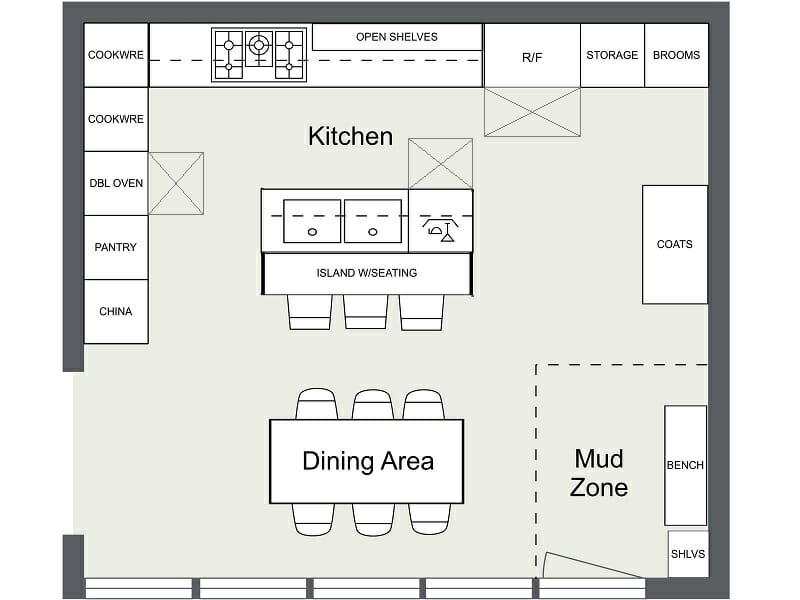
Proper kitchen planning is crucial for a functional, efficient space. It optimizes the area, streamlines workflow, and augments overall aesthetics.
Start by expeditiously measuring the entire kitchen area. This includes the length, width, and placement of doorways, windows, plumbing fixtures, as well as electrical outlets.
Next, establish your kitchen zones – cooking, cleaning, and food preparation. This delineation guides you in outlining the ideal layout for your kitchen.
- Pick a layout style that fits your kitchen – this could be an L-shape, U-shape, galley or island design.
- Factor in traffic flow, ensuring you leave enough space between countertops, appliances, and islands for easy movement.
- Keep the “Work Triangle” concept in mind. This suggests that the sink, stove, and refrigerator should form a triangle for efficient movement.
- Add annotations and symbols to show the location of fixtures like plumbing fixtures and electrical outlets.
Using digital tools such as room planning apps or CAD programs can help you create an accurate floor plan. These provide a digital representation of your kitchen layout.
To better understand your design scheme, use 2D or 3D visualization tools. These allow for necessary adjustments before executing the plan.
Sharing your design with friends or professionals can provide beneficial feedback. This can help identify potential enhancements or areas of improvement.
Finally once you’re satisfied with your design, you should finalize it to serve as a blueprint for your kitchen renovation project.
Finding Inspiration for Kitchen Design

Creating a kitchen that is functional and visually appealing requires careful consideration. Discovering your style in the process is crucial.
Are you drawn to a particular kitchen element? Flip through pictures, explore decorated rooms or even put together a Pinterest board to help guide your preferences regarding colors, materials, and layout.
Understanding your kitchen’s size and layout is equally important. How many people will use the space? What functions should the kitchen serve? Addressing these elements can ensure you design a kitchen that suits everyone’s needs.
The journey of designing your dream kitchen begins with understanding your style, identifying your needs and envisioning how the space will be utilized.
Spare some time to gather inspiration from design websites, blogs, and social media. Visiting showrooms and model homes can also provide valuable insights into how various designs come to life.
Setting a budget is also a necessary step. This helps to prioritize changes based on what is most important to you and what you can afford.
Next comes visualising your space. Developing a floor plan, researching finishes and materials can aid in decision-making. Plan out the workflow in the kitchen for an enhanced cooking experience.
In some cases, seeking professional help might be necessary. Discuss your inspirations and budget with a designer who understands and aligns with your vision.
Lastly, setting a realistic timeline that accommodates potential challenges completes your preparation process. Remember – creating your perfect kitchen is not an overnight task.
Selecting Suitable Materials for Your Kitchen
What are some suitable materials for kitchen cabinets?
Solid wood and stainless steel are robust options for kitchen cabinets, albeit a bit pricey.
Laminate, thermofoil, particleboard, and MDF are cost-effective alternatives, however, they may lack durability.
What are the benefits of solid wood cabinets?
Solid wood is a durable and eco-friendly choice with a beautiful customizable exterior and long lifespan.
However, it’s comparatively expensive and might require regular maintenance due to water damage and termite risks.
Why should I consider plywood for my kitchen cabinets?
Plywood is a lightweight and durable choice made from thin layers of wood. It is also cost-effective and easy to repair.
How do I choose the right materials for my kitchen worktops?
The selection of kitchen worktop materials depends on the practicality of design and the sensations you wish to convey through these materials.
What natural material options do I have for kitchen worktops?
Granite is durable and heat-resistant while marble exudes luxury but requires care due to its softness. Solid wood brings natural warmth but requires periodic upkeep.
What about engineered materials for kitchen worktops?
Laminate offers cost-effectiveness while composite materials offer stain resistance at a similar price to granite. Engineered stone replicates granite’s look without its natural inconsistencies.
Are there any industrial materials recommended for kitchen worktops?
For an industrial touch, consider concrete or stainless steel which resist heat and stains. Glass lends sleekness but handle with care as it’s prone to scratches.
What flooring options can I consider?
Vinyl flooring is wallet-friendly and versatile. Tile flooring is durable but can feel hard underfoot over time. Hardwood flooring is a classic choice with long-lasting charm.
Laminate flooring mimics hardwood or tile at a lower price but isn’t ideal for frequent refinishing.
Choosing Color Themes for Your Kitchen
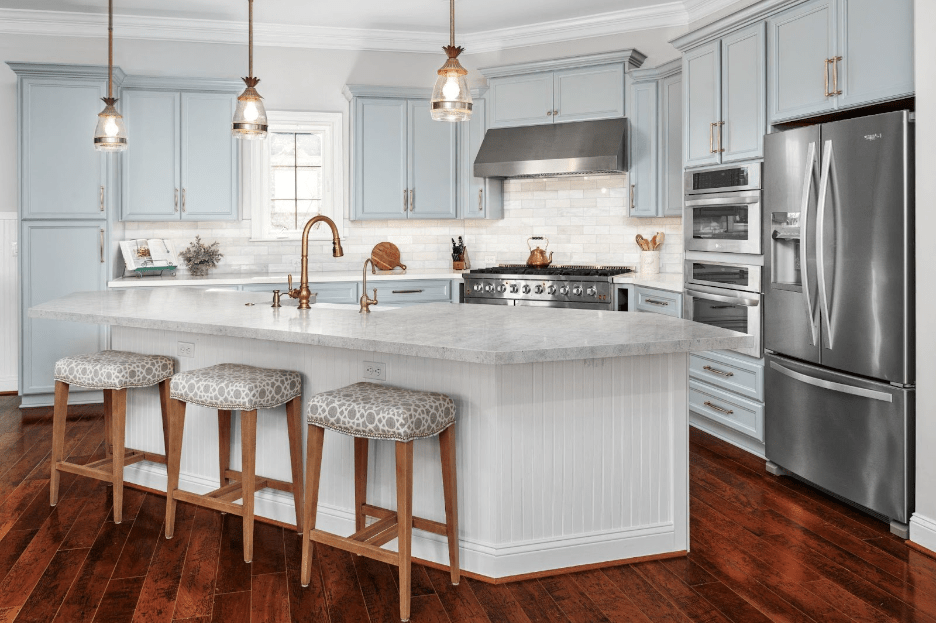
Warm colors like yellow, orange, and red often evoke cozy, vibrant feelings. Cool hues such as green, blue, and purple bring tranquility and refreshment. Balance the two to create an interesting contrast.
Consider the underlying tones in colors – a touch of white softens blue, while black enhances it. Your existing cabinetry, countertops and appliances should harmonize with your selected paint color.
- A contrasting pop of color can ground a scheme that feels overly homogenous.
- A cool accent color will neutralize a warm yellow kitchen.
- Pick three to five colors using a tool like Coolors to create your palette. More than five can be overwhelming.
- Select two key colors from your palette. These shades will be most visible in the design.
Your remaining colors are best used as accents in smaller furnishings or textiles to liven up the room. The key colors you choose reflect the desired style – neutrals for minimalism, bold colors for a dynamic look.
Light hues can make space feel larger – consider white or pale tints on walls and cabinets. The chosen color should resonate with how you want to feel in the space – keep lighting, mood, and personal preferences in mind when making this decision.
- Pantone, Coolors, and Canva are useful platforms for generating cohesive color palettes.
- Timeless schemes include combinations of dark blues and whites or English racing green.
- Fresh atmosphere can be achieved with a pairing of green and blue.
- Darker colors add depth and contrast to larger kitchens.
For farmhouse kitchens, traditional pairings like blue/white or green/yellow create a timeless look. Modern farmhouses often feature combinations of grays with moody blue or grass green. Multiple shades of one color, such as different blues, can give a harmonious feel.
The same soft blue across walls, cabinets, and ceilings, for instance, can elicit a cozy vibe. Experts suggest using light paint colors to reflect light and enhance space. Always remember the importance of contrast – darker cabinets against lighter walls or vice versa harmonize your kitchen decor.
Choosing the Right Worktop for Your Kitchen
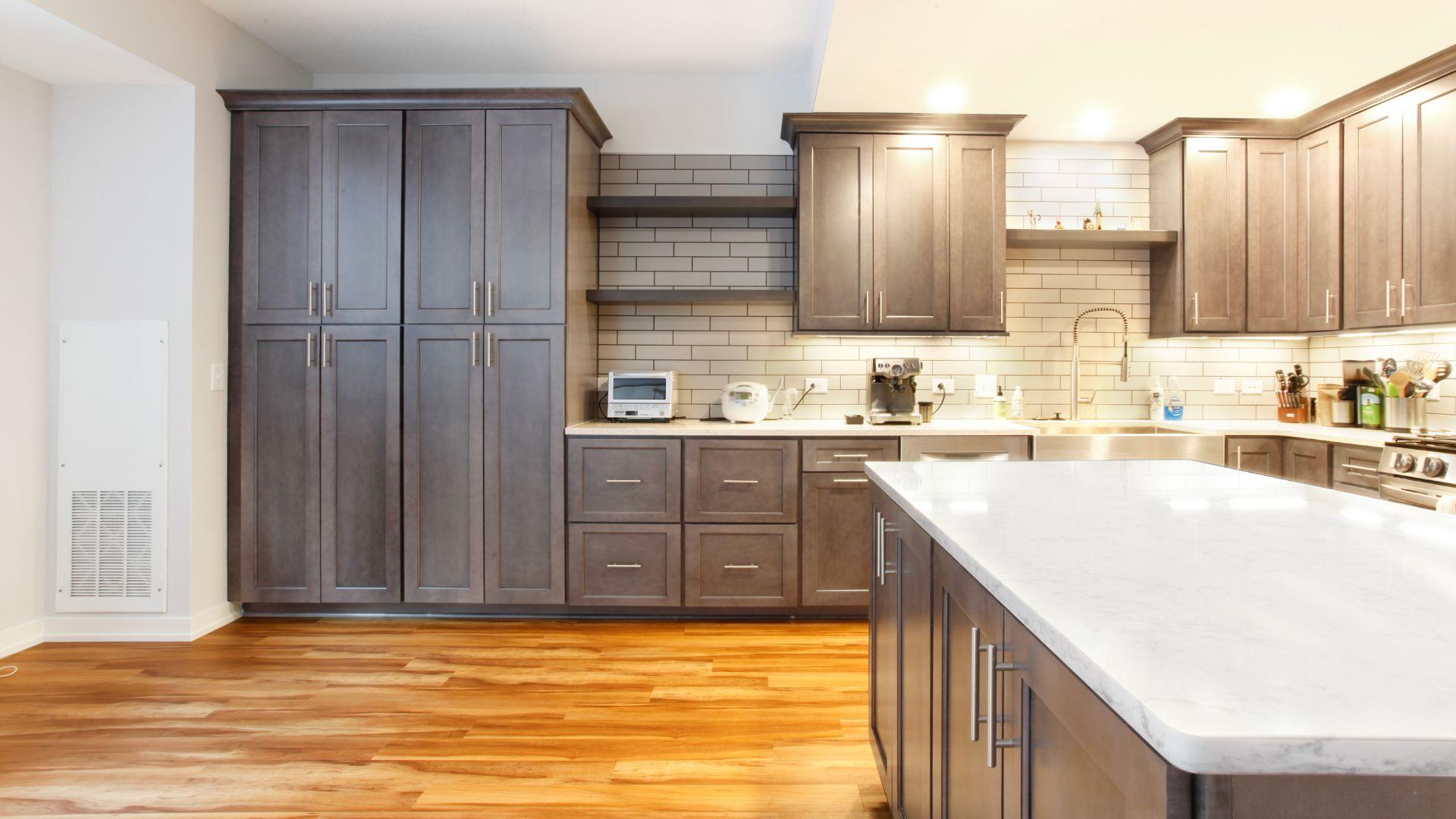
Laminate kitchen worktops, often quite affordable, offer ease for self-installation. Any quick swipe can keep them clean, making them ideal for households in constant use.
Lamination techniques have advanced to effectively imitate genuine stone or wood. This means you get high aesthetic value at a fraction of the cost.
Maintaining Laminate Worktops
These worktops are damage-resistant and inhibit bacterial growth. However, they are susceptible to irreversible scratches and aren’t suitable for all sink types.
Wooden Worktops: A Natural Touch
Wooden worktops bring a unique charm to any kitchen. They’re available in various colours and are ideal for those seeking an eco-friendly option.
Dark timbers like iroko or wenge make strong aesthetic statements, while lighter-toned woods lend contemporary coolness. Regular maintenance is necessary to keep them in top shape.
The Appeal of Copper Worktops
Copper kitchen worktops offer antimicrobial benefits paired with unique patinas. Though direct food prep isn’t advised on copper, its easy maintenance makes it desirable.
Durable Porcelain Worktops
Porcelain kitchen worktops are gaining popularity for their ruggedness and ability to duplicate expensive natural stones without demanding significant upkeep. They’re super-hygienic and simple to maintain.
Porcelain slabs are available in varying thicknesses, proving ideal for sleek, modern designs. However, always ensure the quality of slab before purchase.
Selecting Suitable Flooring and Tiles
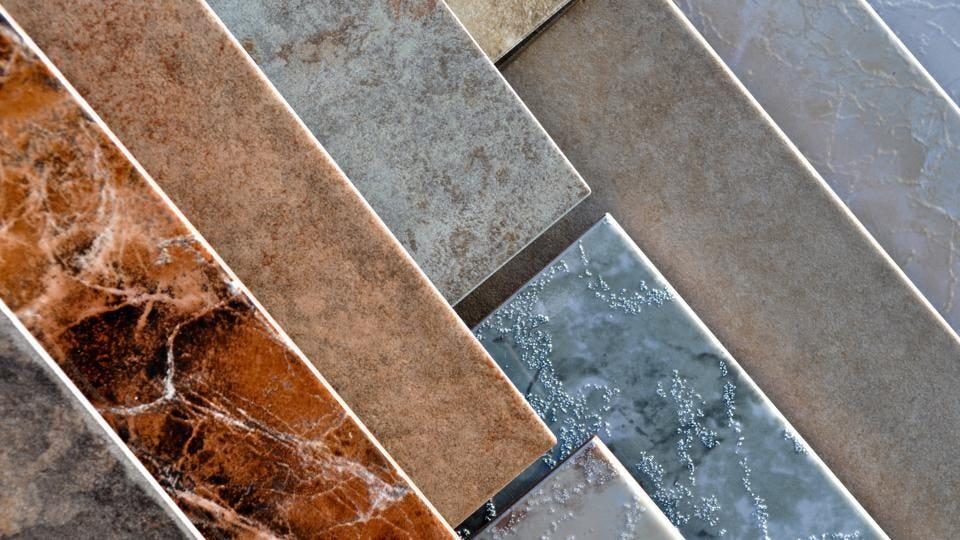
Kitchen flooring must be long-lasting and add character to your space. Tiles and stones are popular options due to their durability.
Discussing product differences with a designer is essential to find the perfect fit considering factors like maintenance and visual appeal.
Variety in Tile Choices
Tiles offer vast variety in colors, shapes, designs, textures, and prices. Their popularity in kitchens can be attributed to their suitability for high-traffic areas.
Finding the perfect tile depends on your kitchen design and style. Your kitchen designer can help guide this decision.
Factors when Choosing Tiles
Durability, style, and functionality are key considerations when selecting kitchen tiles. The chosen tile should complement your overall kitchen design while remaining practical.
Consider factors such as floor finishes and tile distances to ensure aesthetic appeal and maintained functionality.
Selecting Suitable Kitchen Flooring
Your kitchen flooring should be durable and stylish. Contemporary trends balance these two requirements to create visually appealing yet functional spaces.
An ideal kitchen flooring solution balances the need for durability with style, enhancing your overall kitchen design.
Effective Lighting Choices for Your Kitchen
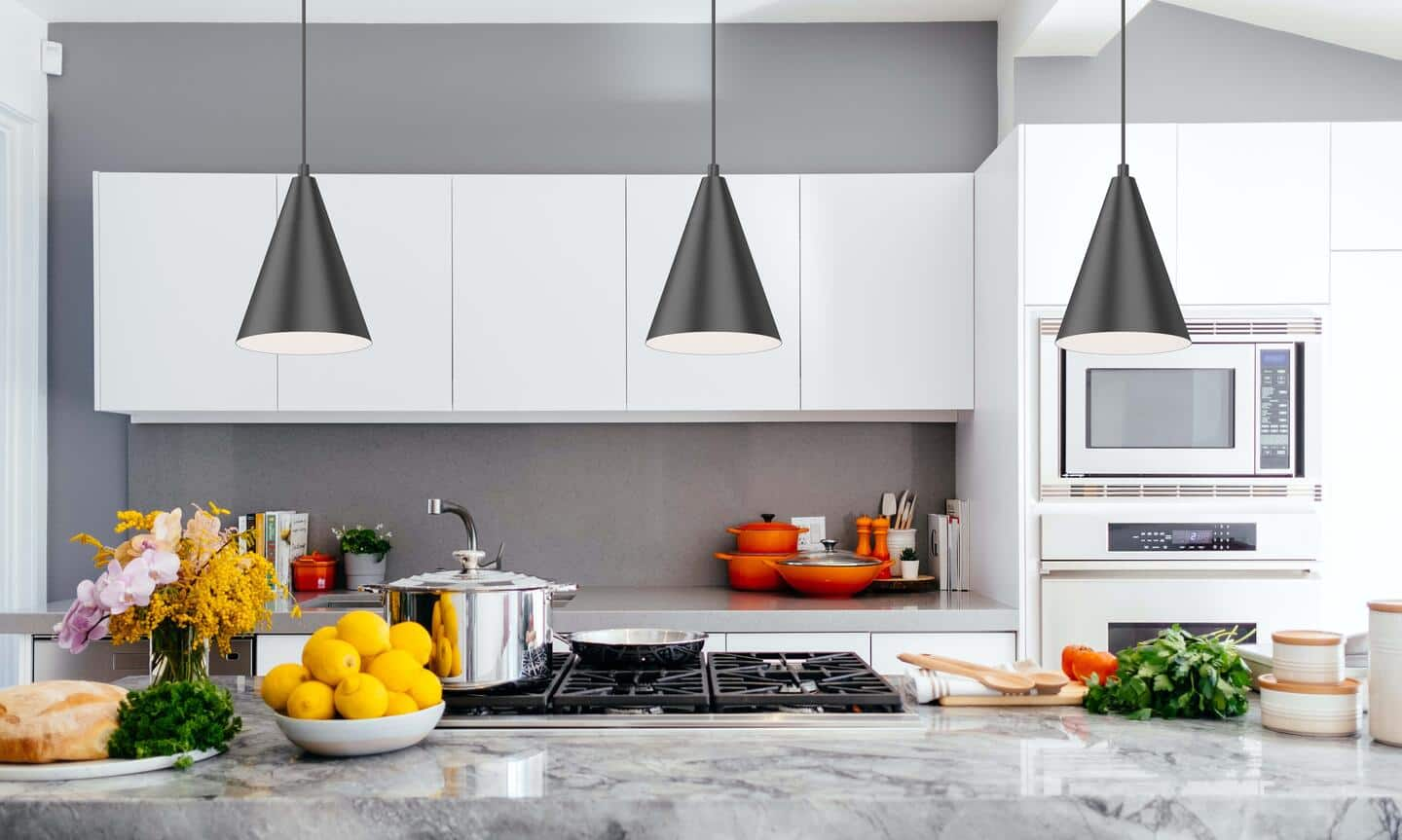
A well-designed kitchen incorporates a layered lighting strategy. This includes ambient lighting for gentle overall illumination, task lighting for specific work areas and accent lighting for highlighting features.
The color temperature of your lights is pivotal, influencing both ambiance and practicality. Cool white light (3500K-5000K) is bright and energetic, suitable for task areas, while warm white light (2700K-3000K) provides a softer, cozier glow, ideal for ambient and accent lighting.
Consider the Color Rendering Index (CRI) when choosing bulbs. A high CRI (90+) is recommended for task areas to ensure colors are displayed accurately. Meanwhile, lumen output affects brightness; select higher lumens for brighter tasks, and lower for subtler effects.
In areas prone to moisture and dust such as near sinks or stoves, select lights with an IP rating of IP44 or higher. Testing different lighting options before finalizing is also invaluable to achieving your desired effect.
| Lighting Type | Description | Usage |
|---|---|---|
| Pendant Over Island | Stylish, functional | Task lighting |
| Under Cabinet Lighting | Even, no glare | Task-oriented lighting |
| Recessed Lighting | Seamless ceiling integration | Ambient lighting |
| LED Strip Lighting | Versatile, flexible | Task or accent lighting |
| Censible Track Lighting | Adjustable placements and angles | Customizable lighting |
| Table 1. Popular Ideas for Kitchen Lighting | ||
Diffusers and emergency lighting are essential components of a commercial kitchen’s lighting design, ensuring safety and even brightness.
Note that the guidelines shared here are relevant to both home and commercial kitchens. Every kitchen is unique, so it’s crucial to tailor your choices to your specific needs.
Utilizing Kitchen Dressings for Added Style
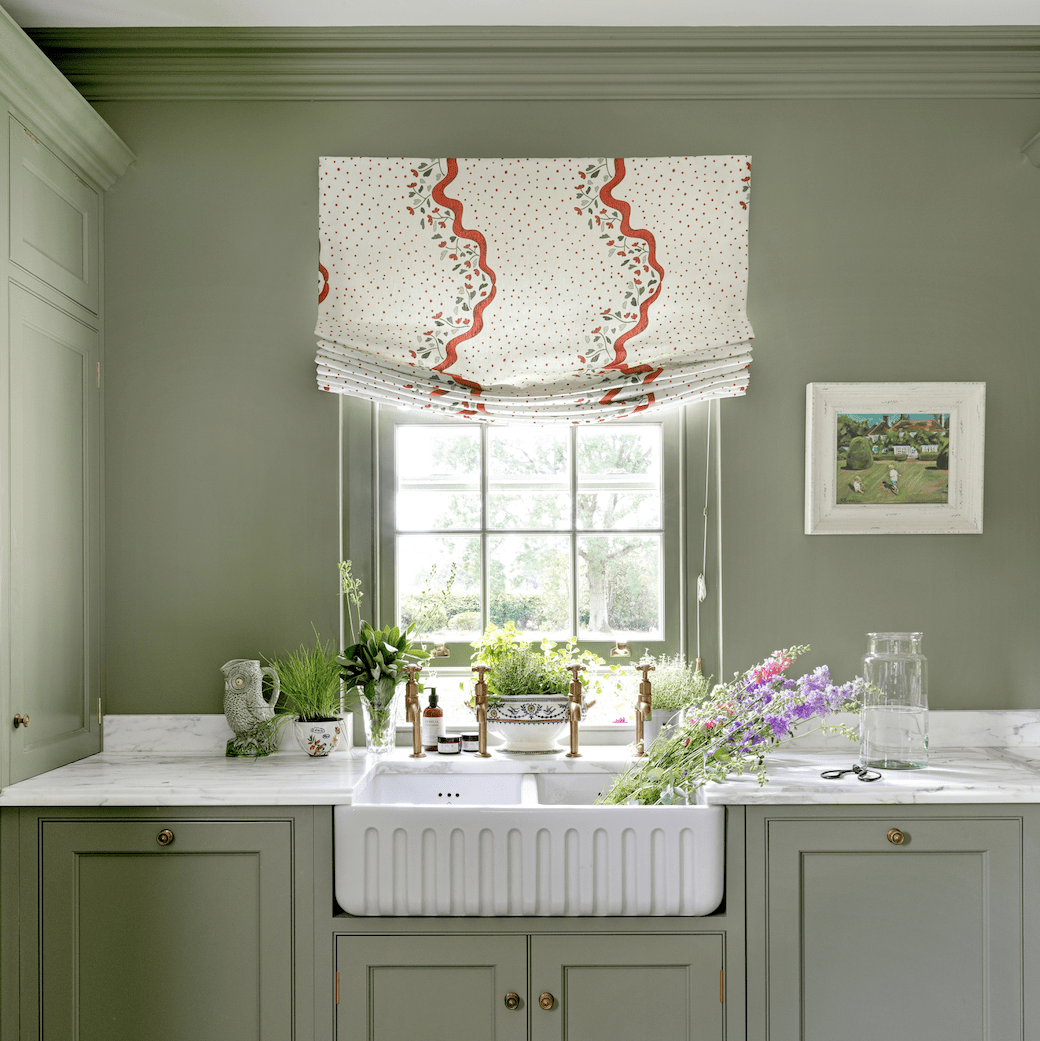
The U-shaped kitchen layout reigns supreme for large kitchens, boasting fantastic efficiency and storage capabilities. This design lends itself perfectly to the integration of a dedicated dressing area.
The L-Shaped Kitchen Layout
L-shaped layouts present a popular option, known for flexibility and functionality. The continuous workspace allows for effortless navigation between the sink, stove, and refrigerator.
Such a design is effective in integrating kitchen dressings into the cooking process, further enhancing your culinary experience.
The Galley Kitchen Layout
Optimized for smaller spaces, galley kitchens offer sleek efficiency. Despite their compact size, they provide ample opportunity to display dressings prominently, uplifting the visual appeal of your kitchen.
The Island Kitchen Layout
Incorporating a central island into your kitchen design not only provides extra counter space and storage but also introduces an element of visual interest. This additional space proves invaluable when showcasing your chosen kitchen dressings.
The Peninsular Kitchen Layout
A variation of the U-shaped layout, peninsular kitchens offer further counter space and storage. They also help create dedicated areas for meal preparation and displaying dressings – adding to the overall aesthetic.
Your choice of kitchen layout plays a crucial role in the incorporation of dressings into meal prep, ultimately transforming the look and feel of your kitchen. Your creativity knows no bounds!
Finding the Balance: Cabinets Proportions, Scale and Symmetry
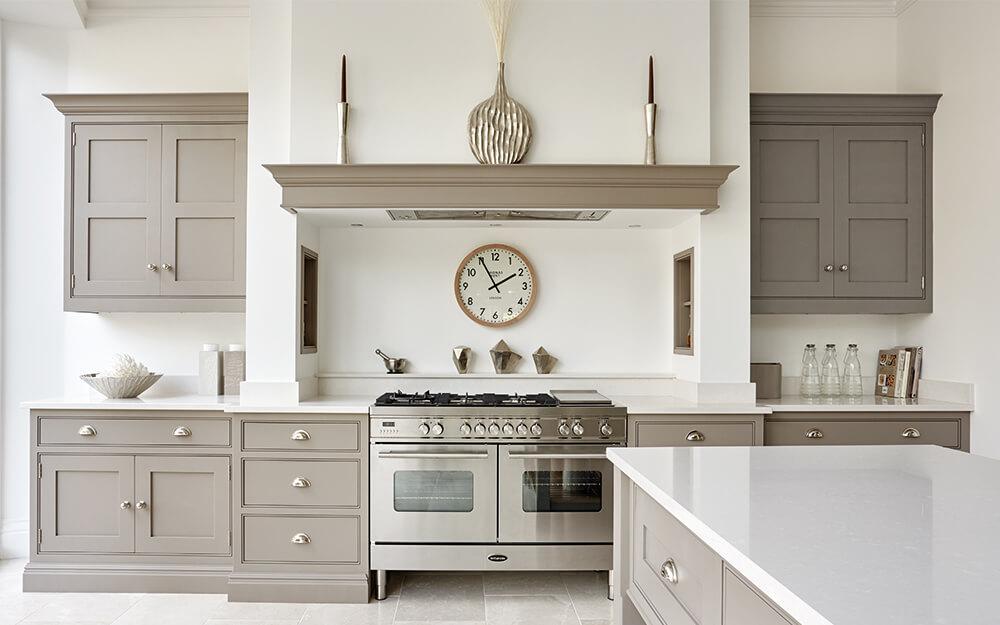
When you master cabinet placement, you create symmetry. Achieving symmetry means aligning cabinets on either side of a key element such as your stove or sink.
This not only ensures a visually balanced layout but also offers practical advantages. It provides equal storage and counter space on both sides of your primary work areas.
Bolster your symmetrical theme with strategically placed lighting fixtures. Whether pendant lights or recessed ones, they enhance kitchen balance when cautiously spread out.
With appliances, though symmetry isn’t compulsory, mindful location can aid in concealing asymmetric spaces. Matching appliances opposite each other produce an even look.
| Key Design Features | Functional Benefits |
|---|---|
| Cabinet Placement | Creates storage space and balances layout. |
| Lighting Arrangement | Enhances visual balance. |
| Appliance Placement | Aids in concealment of asymmetrical spaces. |
| Material and Colour Selection | Promotes sense of symmetry. |
| Key Design Features and Functional Benefits | |
The table above outlines the primary design elements we’ve discussed so far, along with their functional benefits.
Consistent materials and color schemes foster symmetry. For example, using similar countertops or maintaining harmonious color patterns creates a pleasing visual connection.
While striving for aesthetics, remember to prioritize functional balance. Your kitchen layout should maximize usability and efficiency to make cooking a breeze.
Scale and proportion also matter; they make your kitchen visually appealing. Scale is the size ratio of objects in a space, while proportion is the size relationship between different parts of one object.
Remember to choose appliances and fixtures that scale well with the kitchen’s dimensions. Likewise, ensure that the cabinetry hardware is proportional to the size of the cabinets.
Visual balance integrates all elements in your kitchen seamlessly. It’s what sets apart functional kitchens from aesthetically pleasing ones.
Symmetry around architectural features, such as a chimney, creates a central statement piece. Open shelving, flanked by balanced cabinets, ensures easy access to ingredients or crockery.
You can introduce asymmetry for an eclectic touch. Inject vibrancy with colorful cabinets taking precedence over symmetrical alignment.
Symmetry in kitchens balances scale, color, and proportions for a calm and timeless space.
Planning a new kitchen layout doesn’t have to be complicated when you master these principles. Balancing symmetry and scale makes your room serene, and carefully chosen color shades enhance this effect.
Paler shades brighten darker corners while rich colors like Avocado evoke warmth. Light materials such as Silestone Snowy Ibiza countertops create visual space and promote balance.
Designing with symmetry positions your cooking station or kitchen island as central points. Uniformity in size or equal spacing yields greater balance and flow.
Your cabinetry and appliances should scale appropriately with the rest of your kitchen’s space. Ensure there’s enough walking space around large elements such as an island.
In narrow kitchens, opt for breakfast bars with stool seating. Large islands can accommodate sinks and appliances when wall space isn’t adequate.
Entertainer’s Kitchen Victory
In designing a kitchen for the entertainer in Sydney homes, balance is key. Opt for an open layout, utilise clever storage solutions and invest in quality appliances that suit your entertaining needs. A kitchen island can provide a focal point for socialising while having enough counter space and seating are essential. Remember, your kitchen should reflect your entertaining style.
- Kitchen Oasis. Fusion of Relaxation and Functionality (AU) - November 2, 2024
- Pure Water Pleasure. Why You Should Consider Installing a Kitchen Water Filter - October 22, 2024
- Green Plumbing Practices. Eco-Friendly Ideas for Your Melbourne Kitchen - October 2, 2024
Related posts:
 Designing a Kitchen for Multigenerational Living (AU Homes)
Designing a Kitchen for Multigenerational Living (AU Homes)
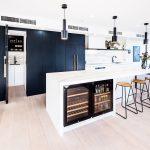 Hamptons Chic vs. Industrial Modern: Kitchen Design Inspiration for Sydney Homes
Hamptons Chic vs. Industrial Modern: Kitchen Design Inspiration for Sydney Homes
 Coastal Kitchen Chic. Designing for Sydney Beach Living
Coastal Kitchen Chic. Designing for Sydney Beach Living
 Open Floorplan Kitchens: 8 Key Design Tips for Your New Brisbane Kitchen
Open Floorplan Kitchens: 8 Key Design Tips for Your New Brisbane Kitchen
 Pet-Friendly Spaces. Designing Your Aussie Kitchen for Furry Friends
Pet-Friendly Spaces. Designing Your Aussie Kitchen for Furry Friends
 Top Kitchen Trends for Stylish Aussie Homes in 2024, 2025 and Beyond
Top Kitchen Trends for Stylish Aussie Homes in 2024, 2025 and Beyond



